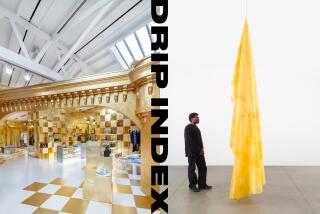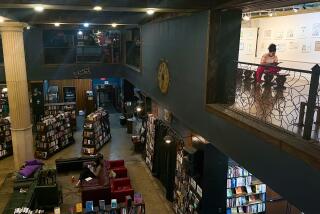Gallery Hung Up by Recession : Art: Once high-flying Martin Lawrence has lost investors and shoppers, partly because of the economy and the defection of the company’s most popular painter.
Art alone endures, it is said, but art galleries’ profits have proven much more fickle.
Such is especially the case at Martin Lawrence Limited Editions Inc., a Van Nuys-based chain of shopping-mall galleries that is having its worst year because of the soft art market, the recession and the defection of its most popular artist.
Investors and shoppers have been fleeing the once high-flying company, which is headed for its first annual loss after three consecutive years of double-digit leaps in sales and profits. Nine stores have been closed so far this year, and Martin Lawrence’s stock has plunged from a high of $13.50 a share in 1989 to $1.75 on Monday.
This year Martin Lawrence has had three quarterly losses in a row totaling $5.6 million on revenue of $18.7 million, contrasted with a nine-month profit last year of $3.4 million on revenue of $37.4 million.
Meanwhile, the company’s bank has alleged that Martin Lawrence is in violation of a term of its loan agreement, but the bank has waived the violation until Dec. 15 while the parties work out a modified agreement, according to documents filed with the Securities and Exchange Commission. The company disagrees with the bank’s claim.
“In our business the recession started like a water tap being turned off,” said Martin S. Blinder, Martin Lawrence’s chief executive and chairman, who founded the company in 1976. Martin Lawrence has cut its corporate work force to 100 from 135, mainly through attrition, Blinder said.
The company plans to close two more stores before year’s end and may close more next year if sales don’t improve, said chief financial officer Allen A. Baron. “Given our cash and our credit facility . . . and given the present conditions, we should be able to see ourselves through next year,” Baron said.
It’s been a painful setback for a company that was a hit in the 1980s with its concept of selling graphic reproductions of original artworks to middle-income consumers who can pay for the works in monthly installments, much like buying a refrigerator. The graphics--sort of a silk-screen hybrid between an original and a poster--are priced from $500 to $10,000 apiece with an average price of $2,000.
The idea was to sell art en masse by avoiding the snobbishness of traditional galleries--Martin Lawrence posts the price next to each graphic--and by offering limited editions of works supervised and signed by the artist.
But during the recession Martin Lawrence’s prices proved too high for many consumers, and investors began pulling out as well.
USF&G;’s Over The Counter Securities Fund, which owned 9% of Martin Lawrence’s stock, decided last spring to sell all of its 590,000 shares of Martin Lawrence. “There were questions . . . about whether they were selling fine art or not, and whether or not they were offering value to the people that were buying the stuff,” said Binkley Shorts, a Boston investment adviser who oversees the fund. “The prices that they were asking were increasingly out of touch with the American consumer’s tastes,” he said.
Shorts believes the company will survive if it gets out of its most expensive gallery leases and sells some of its high-priced inventory of original art, including Andy Warhol’s oil painting “210 Coca Cola Bottles,” which Martin Lawrence bought in 1988 for more than $1 million. The huge canvas now hangs behind Blinder’s desk at the company’s headquarters.
Other problems include that for years Martin Lawrence has relied heavily on one artist--Hiro Yamagata--with whom the company now is entangled in bitter lawsuits over alleged breach of contract by both parties. In the mid-1980s Yamagata’s works accounted for more than half of Martin Lawrence’s sales, but they trickled to about 18% in the September quarter after he stopped producing art for the chain when his contract expired last December, according to documents filed with the SEC.
But Blinder remains undaunted, and he’s betting the company will weather the economic slump by promoting new artists, cutting costs and expanding retail and catalogue operations targeted at consumers who can’t afford a graphic at one of Martin Lawrence’s 34 galleries.
Since the cutoff of new Yamagata works, Martin Lawrence has been negotiating with other artists for exclusive publication rights to their works. And the company is trying to fill the void with works by artists already in its stable, including Susan Rios, Linnea Pergola and Mark King.
Meanwhile, Martin Lawrence is changing strategy and pushing mail-order catalogue items in the $25 to $500 range, including a line of products under the name “Think Big!” that feature oversized replicas of pencils, ketchup bottles, tennis balls and the like. It’s somewhat along the lines of Warhol’s paintings of bigger-than-life Campbell’s soup cans, except that these are real objects. Some have practical uses--there’s a big ceramic Oreo cookie that can be used as a cookie jar (price: $64.50), but most are purely decorative.
“It sort of breaks down the barriers,” Blinder said hopefully of the lower-priced products. “People say those are things we can afford.”
How many people will buy enough of them is another question.
The company recently sent out 650,000 catalogues showcasing the Think Big product line, which it hopes will be a big hit for Christmas. (Last holiday season it sent out 200,000 catalogues but Blinder and Baron declined to say how much revenue was generated.)
It’s a tough time to be in the mail-order business, however, due to increased competition and the recession. Last year catalogue sales nationwide grew only 6% compared with 10% in previous years, according to industry analysts. And earlier this year, two major catalogue houses, women’s apparel marketer Sporting Life and furniture maker Yield House filed for reorganization under Chapter 11 of the bankruptcy laws, citing the recession.
But Martin Lawrence doesn’t want to limit the products to catalogue sales, so it has opened two Think Big stores that exclusively sell these oversized products. Another store, in Palm Springs, sells both graphics and Think Big products, and for the holidays Martin Lawrence is opening three Think Big kiosks, or temporary shops set up in mall walkways.
Another push has been a line of lower-priced sculpture, ceramics and gift ware products, including quaint dolls called “Poupee Millets” and funky phones designed by artist Hollis Fingold. Martin Lawrence sells these items in so-called “museum shops” that share space with 24 Martin Lawrence galleries and are modeled after gift stores in museums.
Blinder hopes customers who buy the less expensive products will come back later to purchase a Martin Lawrence graphic, but since the recession’s start, the rate of graphic sales have slowed, he said.
Then there’s the continuing slump in the art market, reflected recently in lackluster bidding at the fall auctions of Christie’s International PLC and Sotheby’s Holdings Inc. The auctions are a barometer of the art market in general, and they eventually affect sales of graphics at Martin Lawrence galleries.
The tough times have forced Martin Lawrence to tighten its belt: Blinder, Baron and Martin Lawrence President Barry R. Levine have each taken two pay cuts this year--although Blinder will still earn more than $430,000 in 1991, compared with $663,721 in salary and bonuses last year. (Last year the company also paid Blinder $627,000 for artworks that he had bought for $66,825, according to proxy statements.)
Even the company’s zippy annual reports, which doubled as colorful calendars featuring a copy of a Martin Lawrence artwork for each month, have been pared back this year to include only a single, bland-looking calendar on the back cover.
Martin Lawrence Limited Editions at a Glance Martin Lawrence Limited Editions Inc., based in Van Nuys, made big profits in the late1980s when it sold art in shopping malls though its chain of galleries. But the recessionhas hurt the business, and now the company is headed for its first annual loss.
More to Read
The biggest entertainment stories
Get our big stories about Hollywood, film, television, music, arts, culture and more right in your inbox as soon as they publish.
You may occasionally receive promotional content from the Los Angeles Times.










